Tuesday, March 12, 2.40 p.m. EST
Mediterranean bass prices rising again
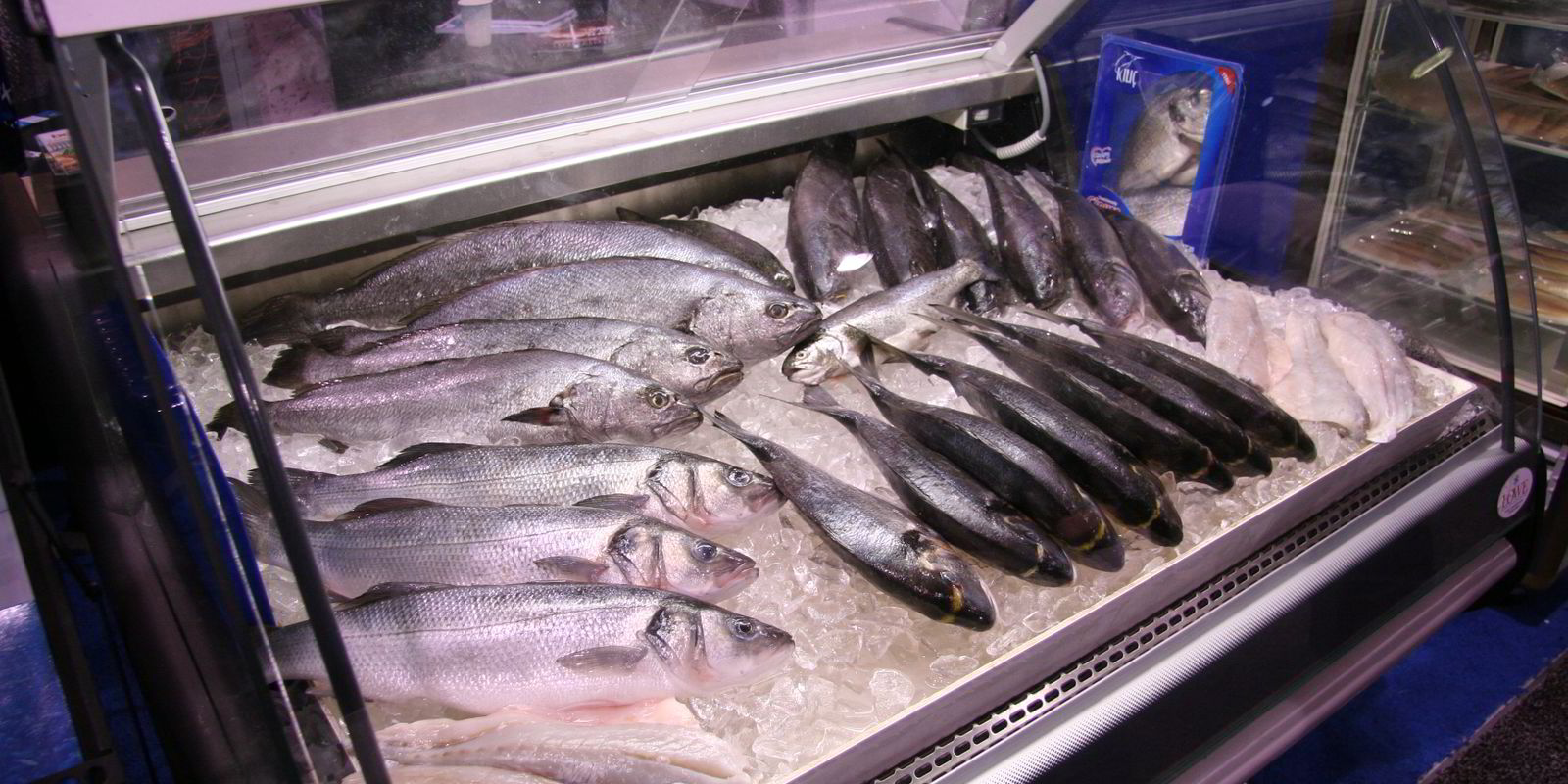
Fish of 400-600 grams are fetching prices of €5.80 ($7.51) in Greece, Sinan Kiziltan, vice president of the executive board at Turkish producer Kilic told IntraFish.
The value of the fish “drastically dropped” by the end of 2012, due to “cash flow problems of Greek companies,” he said.
The market is healthier, and prices are expected to remain stable until this summer.
Nevertheless, consolidation is a must to bring more stability into the sector, he said.
“Somebody will have to take the action,”Kiziltan said, speculating Dias and Selonda could be at the forefront of the movement – with private equity firm Linnaeus playing a major role.
-- Elisabeth Fischer
--------------------------------------------------------------
Tuesday, March 12, 2.30 p.m. EST
Friosur: ‘We want to play an active role in Chile’s consolidation’
Chilean salmon farmer Friosur, which recently acquired several Chilean production licenses from Leroy AS in Aysen, Chile, will look into further mergers and acquisitions in the future.
“The industry needs to go through this process,” Joachim Wessel, general manager at the company, told IntraFish. “We want to be an active player.”
Wessel wouldn’t share any specific details but said there are several interesting developments in the sector the company is closely following.
-- Elisabeth Fischer
---------------------------------------------------
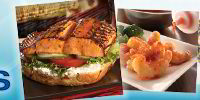
Tuesday, March 12, 2:10 p.m. EST
‘US needs organic aqua standards’
Ecuadorian shrimp farmer Langosmar wants to work more in the United States -- but the organic producer said without organic aquaculture standards, it’s difficult.
The 30-year-old family-owned farmer became organic certified in 2005, but exports mainly to Europe because the United States lack of standards, Maria Jose Aguayo told IntraFish. US buyers’ unwillingness to pay a bit more for organic is a challenge, too.
“It’s a little more expensive because it is harder to grow,” Aguayo said. “People are more price aware than quality aware here.”
--Avani Nadkarni
-------------------------------------------------------
Tuesday, March 12, 2:05 p.m. EST
Ecuador company predicts even better 2013
Ecuadorian shrimp saw an excellent year in 2013, as the amount imported to the United States rose due to the crisis at Asia’s farms—and one shrimp farmer thinks this year will be better.
“2012 was a good year but I think 2013 will be better,” Quirola’s Cesar Estupinian told IntraFish. The company has several farms in Ecuador and sells into the United States and Europe.
--Avani Nadkarni
------------------------------------------------------
Tuesday, March 12, 2 p.m. EST
One Ecuadorian company selling much less to US
While other Ecuadorian companies are selling more to the United States of late, Corinto has drastically reduced its exports.
As opposed to the farmed shrimp most Ecuadorians export, Corinto exports mostly wild-caught fish and squid and much of it is HGT. The company used to export 80 percent to the United States and 20 percent to the rest of the world and now they export only 15 percent to the US, Sales Director Mauricio Trujillo told IntraFish.
“It maybe has to do with the types of products we process,” he said. “People in the states are used to having fillets.”
--Avani Nadkarni
------------------------------------------------------------
Tuesday, March 12, 12.30 p.m. EST
FOS: We grow 30% every year
In the past two years Friend of the Sea has grown its certified fisheries and aquaculture producers by 30 percent annually, Paolo Bray, its director told IntraFish.
“We get around one application a day, about 300 per year,” said Antonio D’Agnelli, FOS’ customer relationship manager.
About 100 out of all applications are passing the audit every year, he said.
-- Elisabeth Fischer
--------------------------------------------------------
Tuesday, March 12, 12:10 p.m. EST
Sysco launches fresh fish line
Sysco is at the show again with its own booth. The reason? The distribution behemoth is introducing a fresh fish program under its corporate Portico line.
The company will also be doing some direct processing of seafood through its affiliate companies.
-- John Fiorillo
---------------------------------------------------------------------

Tuesday, March 12, 12:00 p.m. EST
Trident features spicy shrimp
Trident Seafoods is featuring its Pubhouse Beer-Battered Seafood line at the show. The line includes all the usual species -- cod, haddock, pollock -- but has one interesting addition -- shrimp, the company's first ever shrimp product.
The craft beer-battered shrimp was served up at the show with a spicy buffalo-style hot sauce that has plenty of kick.
-- John Fiorillo
---------------------------------------------------------------------
Tuesday, March 12, 11.30 a.m. EST
The year of the retailers
Verlasso had a massive year in 2012 and this year is going to be the same, said director Scott Nichols.
''Last year was the year of the distributors,'' Nichols told IntraFish. ''This year is going to be the year of the retailers. We want our salmon to be available to people.''
Right now, the salmon on the market is split about 50/50 with distributors and retailers, he said. He's also continuing to work with chefs, who he said ''have the most cutting-edge ideas about food."
-- Avani Nadkarni
---------------------------------------------------------------------
Tuesday, March 12, 11.20 a.m. EST
Yemenese company looks to Americas
First-time IBSS exhibitor Burum Seafood, based in Yemen, said although Europe and Asia are their main markets currently, they are now looking to the Americas.
“We've gotten to know some markets that we didn't know before,” Managing Director Ali Al-Habashi told IntraFish, adding that his $25 million company provides fresh and frozen lobster, kettlefish, pelagics, grouper, among other species.
-- Avani Nadkarni
---------------------------------------------------------------------
Tuesday, March 12, 11.a.m. EST
Icelandic salted cod eyeing bigger Canadian market share
Canada will prove to be a strong market for Icelandic fishery products, Hlynur Guojonsson, Trade Commissioner at the Consulate General of Iceland, told IntraFish when we stopped by the Icelandic booth.
Between 2011 and 2012, sales to Canada increased by 100 percent, he said. Salted cod in particular proved to be a top seller, with 5,000 metric tons going to Canadian consumers last year.
The focus is on growth, Guojonsson said, especially because salted cod is seeing lower volumes consumed in southern Europe due to the financial crisis there.
Haddock and herring will be other key export products.
Iceland’s plan is supported by improved logistical settings, Guojonsson said, with the first direct freight flight having gone out from Iceland to Toronto on March 8.
This will be expanded further when in October 2013 the Open Sky Agreement comes into force.
“This will open up the market for fresh fish,” Guojonsson said.
-- Elisabeth Fischer
---------------------------------------------------------------------
Tuesday, March 12, 10.38 a.m. EST
Frozen supplier to tap into growing Brazilian, Argentinian markets
US food company Quirch is eyeing the growing Brazilian and Argentinian markets with its Panamei frozen seafood brand.
“We’re trying to develop relationships there,” said Jorge Roza, marketing manager at Quirch, “but we’re not there yet.”
The company, which established the Panamei brand six years ago, has good connections to Peru, with a sales office there, and sees Latin America as a growing and expanding market for frozen seafood.
-- Elisabeth Fischer
--------------------------------------------------------------------

Tuesday, March 12, 8:16 a.m. EST
Good luck for the baby…
Canadian seafood company Ocean Choice is venturing into China with the latest addition to its range: sea cucumber.
“We’ve introduced them this year and they are a big thing in China,” one spokesperson said, when IntraFish visited the company’s booth at the Boston show.
While the product is not very nice to look at, it’s a delicacy in China, he said -- especially among pregnant women, said to bring god luck for the unborn child.
The sea cucumbers are harvested in Canada and while the company wasn’t able to share any specific volumes, the spokesperson said the numbers shipped to China this year are going to be “significant.”
When asked if he had tried the product, he said “not yet.”
-- Elisabeth Fischer
----------------------------------------------------------------
Tuesday, March 12, 08.14. a.m. EST
Panga exporter ventures into US wholesale market
Vietnamese exporter Navico is eyeing wholesale contracts in the United States due to the “high potential” for pangasius and catfish in the market.
The company -- a first-time attender at the show -- recently opened a sales office in LA, California, Phuong Doan, vice director of Navico USA, said, with plans capture more market share.
-- Elisabeth Fischer
----------------------------------------------------------------
Tuesday, March 12, 7:30 a.m. EST
Brand-new label selling to Whole Foods, Wegman's
Just one year ago, Elevation Brands CEO Chuck Marble had just launched seafood brand Blue Horizon Wild -- now he is selling to top US retailers such as Whole Foods and Wegman's.
The brand is "value-added, sustainable, all-natural, convenient," Marble told IntraFish.
The company launched new ready-to-heat seafood items such as seafood cannelloni, which has crab, scallops, shrimp, lobster and pollock in it.
"We're here to learn more about the supply chain," said Marble.
Much of Blue Horizon's fish comes from Alaska.
--Avani Nadkarni
-----------------------------------------
Monday, March 11, 5:10 p.m. EST
Korean companies eye US market
Eight Korean companies showed up to IBSS, eager to jump into the American market.
South Korea-based Hosan was presenting a brand new product for sale into the United States: Dried seaweed for salads. The crunchy product takes just a five minute soak in water to be ready-to-serve, a representative told IntraFish. Hosan was searching for buyers.
"We want to have a good distributor in the US."
--Avani Nadkarni
----------------------------------
Monday, March 11, 4:51 p.m. EST
Salmon's market strength poised to grow
There’s no reason why the growth of the salmon market should come to an end, Martin Ovrebo, deputy CEO at Coast Seafood, told IntraFish.
“The industry has developed and become cleverer with their marketing -- everybody wants salmon,” he said. "Consumers like it at the moment."
Salmon has become more and more available, he said, but at the same time Ovrebo criticized current developments with lower slaughter volumes and higher prices.
“It’s always the same cycle,” he said. A growth rate of 5 to 10 percent would be ideal, “not 31 percent in one year and nothing in the next.”
-- Elisabeth Fischer
-------------------------------------------------

Monday, March 11, 4:45 p.m. EST
Organic certification backbone for mussels’ success
Hopes are high for Newfoundland blue mussels producers to boost demand – and with it prices – after its recent organic certification, Juan Roberts, president at Iceberg Select said.
“It should give us more backbone in the United States,” he said.
Newfoundland mussel producers currently supply 50 percent of their produce to the United States, the rest goes into the domestic market.
-- Elisabeth Fischer
--------------------------------------------------------
Monday, March 11, 3:40 p.m. EST
Pebble Mine: 'We're going to protect our fisheries'
Alaska Governor Sean Parnell on the Pebble Mine issue: If the Environmental Protection Agency (EPA) doesn't prevent it, "as a state, we're going to protect our fisheries and we're not going to promote one resource over another."
--Avani Nadkarni
--------------------------------------------
Monday, March 11, 3:39 p.m. EST
Alaska governor: 'We want to sell MSC and RFM'
“Alaska, along with other states and countries, does a good job maintaining our stock,” Alaska Governor Sean Parnell said in a meeting at the Alaska Seafood Marketing Institute (ASMI ) booth. “That’s why we have pursued an RFM (FAO-based Responsible Fisheries Management) strategy.”
Alaska wants to be able to sell Marine Stewardship Council (MSC) and RFM seafood, he added. As for not having certification at all, “I think certain segments of our industry [look] for certification.”
--Avani Nadkarni
-------------------------------------------------
Monday, March 11, 3:09 p.m. EST
In Mexico, wild and farmed both struggle
Shrimp supplier Ocean Garden, like every other supplier on the US market, is riding the wave of a chaotic shrimp market.
The company, known for its expertise in Mexican shrimp, has had to step away from its roots over the past several years, with the country’s shrimp aquaculture sector being hit by white spot, and the wild sector being hit by low volumes last year.
Celso Lopez, Ocean Garden CFO, said that while there is a premium for Mexican shrimp in the US market, right now the upward pressure is on every species with the shrimp shortage out of Thailand.
The Mexican farmed shrimp sector won’t recover to the 2007-2008 levels, Lopez said, but he expects to see the industry expand at a steady pace over time.
“It should ramp up,” Lopez said. “There’s land, there’s potential, but the fact is that farmers have been hard hit by white spot, and that makes it difficult to get investments.”
The wild shrimp season that just ended Mar. 8 was not a great one. Lopez is hopeful that the upcoming wild shrimp season – which starts next September – will be better.
Ocean Garden National Sales Manager Jim Charters said he hasn’t seen prices rise so quickly in a long, long time.
“The rapid increase in prices has been remarkable,” said Charters. “Americans are used to paying so little for shrimp. We’ll see how it plays out.”
--Drew Cherry
--------------------
Monday, March 11, 3:00 p.m. EST
Fish on a stick
Interest has been very strong at the Harvest Select booth for Alaskan Fsh ‘n Sticks, produced by Chang International and sold in the US through Harvest Select.
The lightly battered, hand-filleted Alaska cod and pollock on a stick is drawing lots of attention from quick-service and other restaurant chain buyers, as well as deli and convenience store operators.
The product can be deep-fried – bamboo skewer and all – and is a natural fit on kid’s menus.
The product is made in Chang International’s plants in China.
-- John Fiorillo
------------------------------------
Monday, March 11, 2:35 p.m. EST
Shining Ocean launches newsurimi product
Seattle-area surimi company Shining Ocean launched a new salmon tempura surimi product, president Robert Bleu told IntraFish.
The product is made with ground Alaska pollock, salmon and whiting.
--Avani Nadkarni
--------------------------------------------

Monday, March 11, 2:13 p.m. EST
MPEDA: India's not giving subsidies
India's Marine Products Export Development Authority (MPEDA) Chairman Leena Nair told IntraFish the country is not giving subsidies to the industry.
The country is named as one of seven under investigation from the US Deparment of Commerce (DOC) and International Trade Commission (ITC), but Nair said "the kind of money we pay to the industry is very, very miniscule." The farms are "tiny," she said, and are "affected by all the vagracies of nature."
"It's no subsidies, its deferring something like 10 percent of the small farmers' costs" if they lose business due to events like natural disasters, she said.
--Avani Nadkarni
-----------------------------------------------------------
Monday, March 11, 2:02 p.m. EST
High scallop prices don't scare us
Atlantic scallop prices are likely to jump this year but that doesn’t scare Wade Wiestling, vice president of culinary development for the Oceanaire Seafood Room restaurant chain.
Scallops were the restaurant chain’s top seller by volume last year, and Wiestling is confident sales will remain steady even in the face of rising prices.
“People like to eat scallops in restaurants; they are less likely to cook them at home,” he said.
The chain only uses fresh scallops and has a good network of suppliers, said Wiestling.
And if you’re wondering what the #2 and #3 sellers are at the chain: seafood mixed grill (combination of fish, shrimp and scallops) and halibut.
The Landry’s owned chain operates 10 restaurants across the United States.
-- John Fiorillo
--------------------------------------
Monday, March 11, 1.29 p.m. EST
Pescanova's crisis pulling down turbot prices
Struggling company Pescanova is threatening other companies in the sector, pulling down turbot prices, Ruth Sedofeito, commercial director at Spanish producer Stolt Sea Farm, told IntraFish.
“When Pescanova entered the sector, the market had to revise prices downward,” she said. The danger now is that other companies might suffer from Pescanova’s failure, she said.
Stolt is, therefore, ramping up its focus on different sectors, in particular sole. The company is currently setting up a sole farm in Iceland.
“The turbot market is too crowded,” she said. With prices expected to further go down, the future of turbot in Europe might not be a bright one.
-- Elisabeth Fischer
--------------
Monday, March 11, 12:50 p.m. EST
Walmart's biggest salmon provider
Previously a middleman for selling fish to other seafood companies, who would in turn sell fish to retail, US-based Yihe Corporation is now breaking out on its own.
The company, which has offices in California, Seattle, Boston and Virginia, is opening a new processing plant in Seattle, Executive Vice President of US Operations J. Dennis Morgan told IntraFish. The company is opening its doors to a 41,000-square-foot plant, which will process salmon burgers for Walmart-owned Sam's Club.
Morgan said Yihe does "most of Walmart's salmon," as well.
--Avani Nadkarni
-------------------------------------------
Monday, March 11, 12:45 p.m. EST
The Saucy Fish Company pushing more tilapia
Tilapia will become a bigger topic at UK-based The Saucy Fish Company, Simon Smith, its sales and marketing director, told IntraFish.
Reasons for this are higher salmon prices, which are “worrying,” he said, with consumption predicted to slow down in the near future.
The company is set to launch a new tilapia product at UK retailer Sainsbury’s in a few weeks, and will put more focus on promotions for the species.
-- Elisabeth Fischer
-------------------------------------------------------

Monday, March11, 12:35 p.m. EST
Learning from chocolate
UK salmon processor MacKnight launched a new range of salmon “fleurettes” in time for the Boston show, following the concept of a chocolate box.
Using rosette cuts of salmon, Greek yogurt blended with hot smoked salmon, the product has been a seller at the show, said Jonathan Brown, CEO of the company.
Packaged in an non-oxygen environment the product has a retail shelf life of 30 days, he said.
-- Elisabeth Fischer
-------------------------------------------------------
Monday, March11, 12:35 p.m. EST
The quirky one

“It’s been incredible, we’ve had so much interest,” said Simon Smith, sales and marketing director, at the company.
Executing a proper brand in its marketing strategy is key to the success, he said. “We’re setting ourselves apart and are a bit quirkier than our competitors -- people love that.”
The company recently ventured into Norway, and is “seeing positive signs there,” Smith told IntraFish.
The United States and Canada are the next markets on the hit list -- both in distribution and retail.
In April, it will launch its ready-to-eat line, and has high hopes for it. The products are following the concept of consumers who “think about the dish not the fish.”
Smith said value-added-products is the way to bring consumers into seafood, and “we’re happy with that,” he said.
-- Elisabeth Fischer
---------------------------------------------------
Monday, March 11, 12:02 p.m. EST
Surimi misperception dragging down sales for US producers
Consumers’ perception of surimi is still the biggest issue US producers are facing, Nick Buscovich, national sales manager at Shining Ocean, told IntraFish.
A number of Chinese producers are importing to the United States, however, “clients don’t trust Chinese producers.”
“About 90 percent of retailers stock American surimi,” he said. Foodservice is more banking on the “cheaper” product from China.
But the “cheap stuff that doesn’t taste good keeps people off,” he said -- not only buyers but also the end-consumers themselves.
“It’s very hard to grow the industry,” said Buscovich, despite most US producers supplying a “pretty good product.”
-- Elisabeth Fischer
-----------------------------------------------------------------------
Monday, March 11, 12:00 p.m. EST
Using it all
Sustainability is the main issue for marine ingredients company Hofseth Biocare, said Geir Even Haberg, CEO of mother Hofseth.
“We want to use 100 percent of the salmon -- including all off-cuts -- and make it available for human consumption,” he said.
“It will make us stronger, as well as our clients,” he said.
-- Elisabeth Fischer
-----------------------------------------------------------------------
Monday, March 11, 11:40 a.m. EST
Social responsibility vs. environmental responsibility
Global Aquaculture Alliance's Steve Hedlund spoke on social responsibility, which he defined as issues relating to child labor, forced labor, wages and worker health and safety, at Mini GOAL.
"Awareness hasn't risen in terms of social responsibility as [quickly] as it has with environmental responsibility," Hedlund said. "But it's no longer taken a backseat to environmental responsibility."
--Avani Nadkarni
------------------------------------------------
Monday, March 11, 11:15 a.m. EST
What's the hottest issue of IBSS?
It may seem too late for Thai shrimp farmers, but Global Aquaculture Alliance (GAA) President George Chamberlain said there is good news for the farming industry in terms of Early Mortality Syndrome (EMS) said at Mini GOAL at IBSS.
After tests done in August and December of last year in Vietnam and confirmed just days ago in Arizona by University of Arizona professor Don Lightner, "we now know that the disease is infectious," Chamberlain said.
"[It was] a critical test of whether it's an infectious disease," he explained. "The good news is progress is being made."
Seafood Exchange President Travis Larkin called the EMS issue "probably the hottest issue of this conference."
--Avani Nadkarni

Monday, March 11, 10:50 a.m. EST
Marlees shows off expanded line
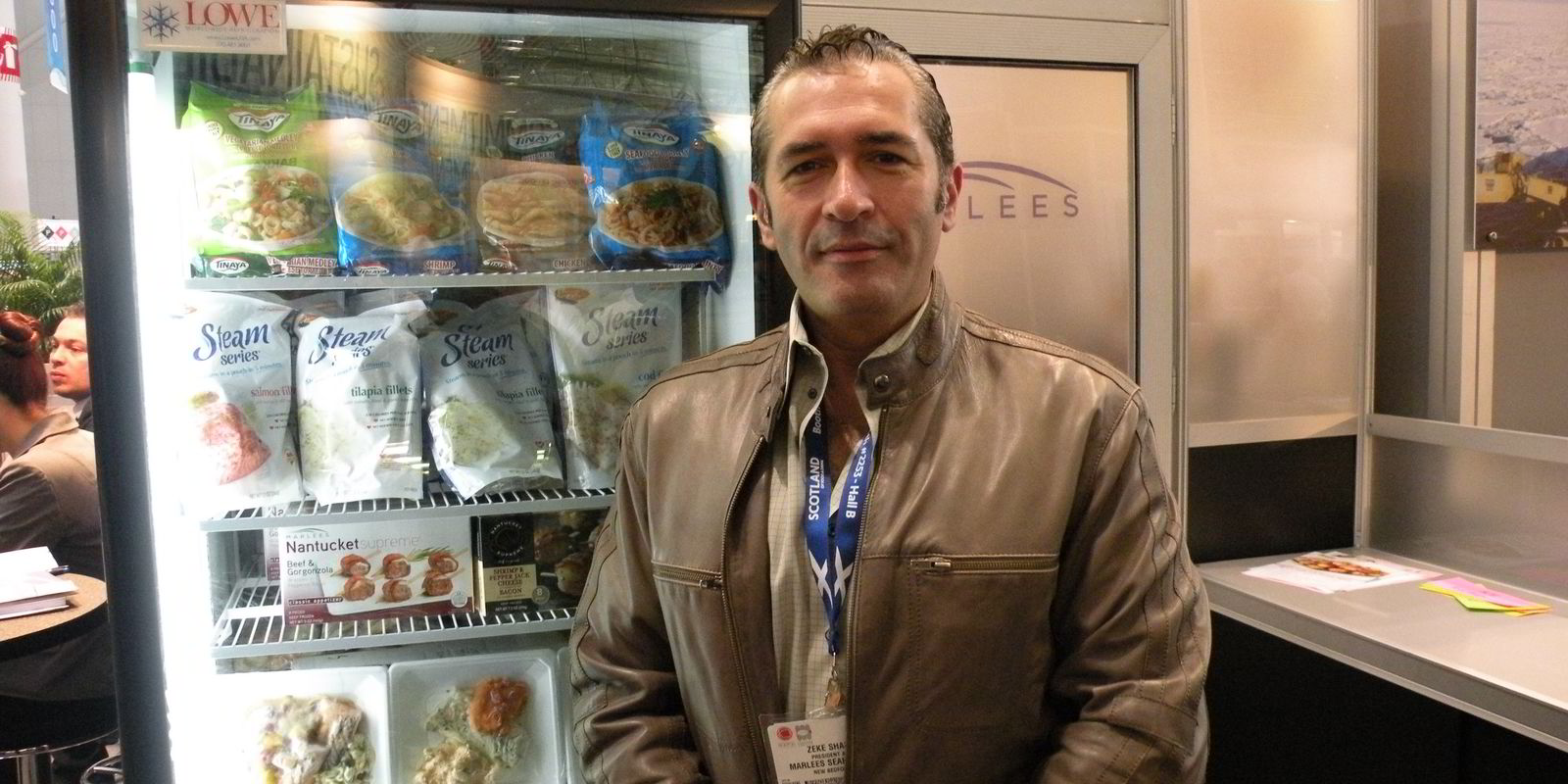
Long regarded as just a scallop producer, Marlees has branched out into other species and value-added items in a big way, and sales are going great, Shahin said.
Shahin joined the company in May, 2012, brought in to lead a turnaround of the $70 million New Bedford, Massachusetts, firm.
Today, in addition to scallops, Marlees offers snow crab, stuffed clams, salmon, shrimp and more. The company has a new line of ready meals in Ahold stores in the United States and other major retailers showed interest in the product when they visited the booth, said Shahin.
-- John Fiorillo
-----------------------------------------------
Monday, March 11, 9:50 a.m. EST
New tech knows if your fish is bad
IBSS exhibitor Bizerba USA introduced a product that allows the industry to see if a seafood product is bad, the company's Pedro Garza told IntraFish.
The product is a sticker that when activated by a UV light changes colors to detect temperature abuse, Garza said. So far, the technology has been successful in Europe and has been approved by the FDA as part of HAACP here in the United States.
--Avani Nadkarni
-------------------------------------------------
Monday, March 11, 9:50 a.m. EST
Lots of interest in Indian shrimp
There's been a lot of interest in Indian shrimp due to the issues facing the other Asian shrimp producing nations, Devi Seafoods' Sree Alturi told IntraFish.
In fact, all of those nations, besides India, saw a decline in shrimp imports to the United States.
"Some buyers that never looked at Indian shrimp are looking now," he said.
--Avani Nadkarni
-------------------------------------------------
Monday, March 11, 7:55 a.m. EST
Offshore cobia farm ready for liftoff
Brian O’Hanlon and his team at Open Blue, an offshore cobia farming venture operating in Panama, has spent the last few years proving the concept of growing fish in open ocean waters eight miles offshore.

The company has spent much of the last year building infrastructure to support its farming operations – there’s a new hatchery and processing plant in development, for example.
Until now, production has been about 200 to 500 tons a year, but O’Hanlon expects his more than a dozen Ocean Spar offshore cages to produce 1,300 tons this year and 3,000 tons next year, which he said will make the fish available to the market 52 weeks a year.
The company is fueled by private equity investors and employs 140 workers. And with 900 hectares of ocean lease space available to the company, O’Hanlon expects to see steady growth in the years to come.
-- John Fiorillo
----------------------------------------
Monday, March 11, 7:42 a.m. EST
Thai processors: Countervailing duties ‘unjustified’
Panisuan Jamnarnwej, president of Pakfood and the Thai Frozen Foods Association, said the United States’ investigations into seven shrimp production nations -- including Thailand -- which could lead to countervailing duties, are "unjustified."
“Let’s not use the word fair or unfair,” he said, “but really it is unfair.”
The background of the investigations would be in one way political, and in the other way led by protectionism, he said.
“No government in the world would not help its companies,” he told IntraFish. “Accusing Thailand to subsidize its companies is a protectionist idea.”
Countries tax their companies differently, and at the same time they subsidize them differently.
All in all, Jamnarnwej believes that the United States “can’t do” without Thai shrimp imports. “The supply is steady, and it’s a predictable and reliable product,” he said.
“We’re not selling any surprises,” he told IntraFish.
-- Elisabeth Fischer
--------------------------------------------

Monday, March 11, 7:45 AM EST
ILO: Seafood companies need to participate
The International Labour Office, a specialized agency of the United Nations, is at the show to meet with buyers and suppliers of Thai shrimp to discuss the ongoing issue of labor abuse practices in the country.
ILO’s stance? The country is making real progress.
“The first step is to recognize there is something to improve, then analyze the scale,” said Tuomo Poutiainen, program manager for the ILO.
The Thai government will meet with industry members Tuesday to give an update on labor issues in the seafood sector; ILO will be there to give its feedback.
“This can’t be done by the ILO alone – we need the industry to participate,” he said.
The ILO is in constant dialogue with major retail and foodservice buyers, all of who have “a corporate risk” in purchasing from a country with potential labor issues.
The United States State Department currently ranks Thailand as a Tier 2 “watch” country, which means there are a multitude of issues that need addressing. The US State Department issues a new report at the end of the year, and shrimp suppliers fear that if Thailand is dropped down to Tier 3, the major buyers will be forced to back away.
While there are very real problems in Thailand, Poutiainen said it’s important that the Thai seafood industry not be singled out as the only country of concern; other countries and industries have plenty of issues as well.
“Have you looked at the report?” he asked rhetorically. “There are a lot of countries in the Asia-Pacific and Latin American regions that need a lot of work.”
Thailand’s focus on improving will hopefully help lift the standards of neighboring countries, he said.
--Drew Cherry
------------------
Monday, March 11, 7:36 a.m. EST
Let's go SIRFing now
You can never have too much research – especially in the seafood industry. That’s the belief of the Seafood Industry Research Fund (SIRF).
SIRF might be better known to some as Fisheries Scholarship Fund (FSF), which was established in 1964.
FSF has been rebranded to SIRF and infused with new energy and a new commitment to fund research vital to the US seafood industry, Dan Didonato of Preferred Freezer and a SIRF board member told IntraFish Sunday at the Boston seafood show.
SIRF is a tax exempt, philanthropic, educational organization, and is supported entirely by voluntary contributions from individuals and companies in and related to the seafood industry.
Each year, the fund makes research grants to colleges, universities and other institutions to conduct research of interest to the seafood industry and the consumers of its products to support scientific research.
SIRF has provided almost $2.8 million for nearly 400 research grants resulting in the publication of approximately 360 related research papers. Research supported by SIRF covers a wide range of topics including studies related to: the health effects of eating fish and seafood; fisheries resource management; developments in aquaculture and acceptance of aquaculture products; Food safety; and new harvesting, farming, freezing, packaging, and processing technologies.
The fund does not engage in political or legislative lobbying, and is affiliated with, but not a part of, the National Fisheries Institute.
For more information contact SIRF at: admin@SIRFonline.org.
-- John Fiorillo
-----------------------------------------------------------------------
Monday, March 11, 7:30 a.m. EST
Secure your salmon supplies
With prices still climbing in the US market, it’s safe to say that Chilean salmon is back – at least on the demand side.
“All we are hearing from our customers is, ‘salmon’s selling fast,’” Camanchaca USA President Bert Bachmann said. “Whether it’s restaurant or retail, the feedback is that consumers perceive it as a value.”
Unlike other years, Bachmann said contracts are being put in place for longer periods of time, and earlier than usual.
“There is a sense that ‘I better secure fish,’” Bachmann said. “For once, price is not the main issue.”
Camanchaca does around 85-90 percent of its business on contracts; currently 75 percent of its contracts are for a period of three months or more.
Customers are for the most part understanding of the price increases, Bachmann said.
“The really respected restaurant and retail buyers want stability,” Bachmann said. “They don’t want to see prices hit below production costs.”
--Drew Cherry
---------------
Monday, March 11, 7:00 a.m. EST
Not jerking around
Brooklyn, New York-based Acme Smoked Foods has extended its King salmon jerky line, and is setting its sights on an entirely new area of sales: sporting goods and convenience stores.
“It’s a huge new learning curve for us,” Gabriel Viteri, vice president of strategy and business development. “We are hitting new channels we have had no experience with, and dealing with distributors we have never heard of.”
The new market puts Acme head-to-head with an American icon: beef jerky.
Viteri is convinced salmon jerky can find a place in sporting goods stores with its flavor and health profile, which fits in with an active lifestyle. Samples have been sent to sporting goods chain Dick’s, and several others are being targeted.
The company recently developed a new flavor for the jerky, orange ginger, and in addition to its 1.25 ounce packs is offering a .6 ounce jerky strip to hit a $2.99 price point, which will help it snap into beef jerky’s territory.
--Drew Cherry
---------------
Monday, March 11, 6.58 a.m. EST
LUF riding the healthy wave
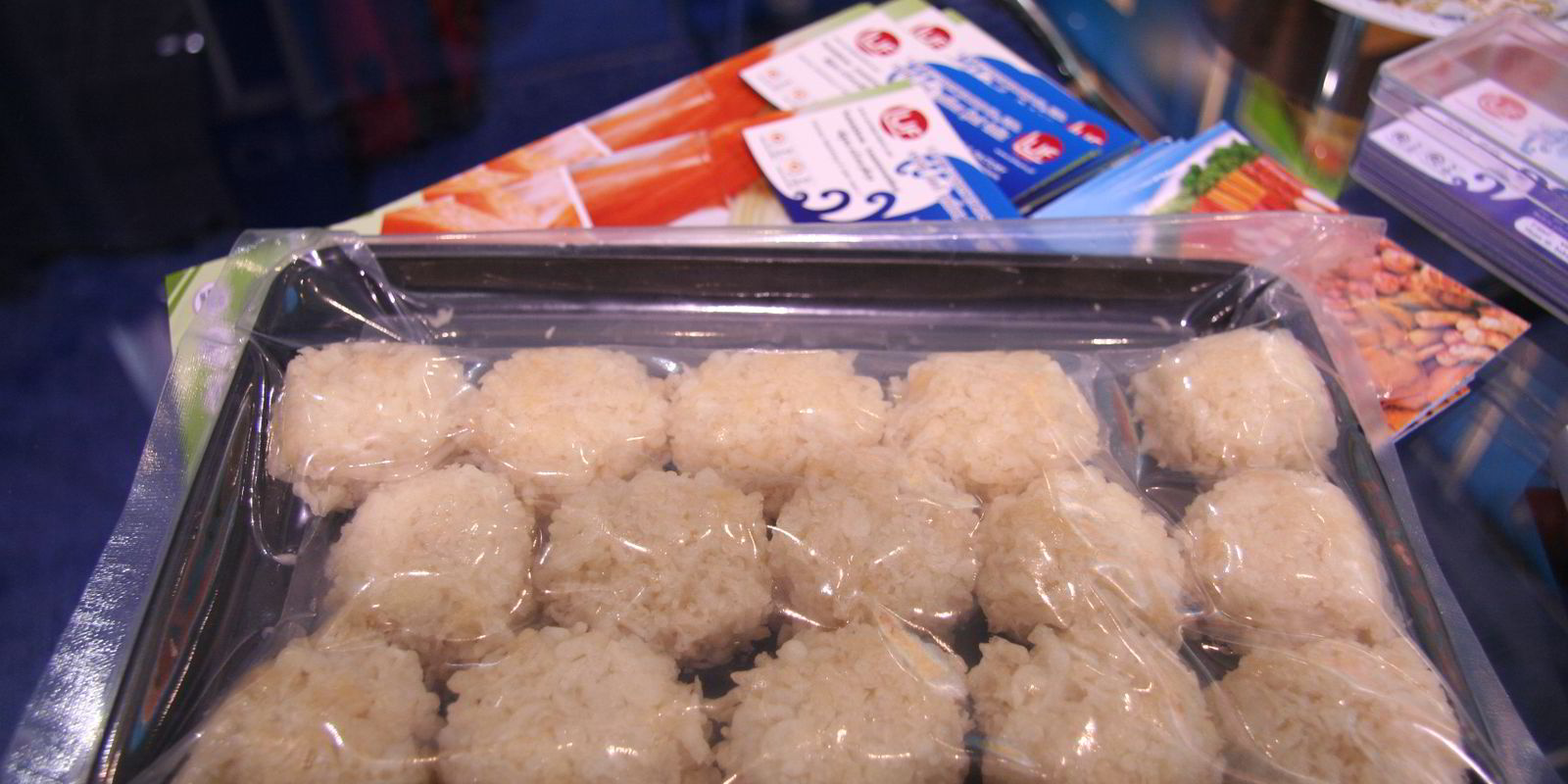
“It’s a Japanese concept but it’s for our US consumers,” said Nattakhom Anantawuttikul, head of oversea marketing and sales at the company.
“Simply put it into the oven -- the crispyness is the same,”he said.
The US market is the “number one” market for LUF, he told IntraFish. Even though consumers want to spend less and less money, it’s still a relatively stable one.
Surimi producers, however, face price competitions -- with more than 80 percent of products coming from imports.
“But there is still a gap to fill in and we expect to grow volume this year,” Anantawuttikul said.
The company recently employed a new product manager to “create items to differentiate ourselves from competitors.”
“We have to create,” he said, with more healthy option being the first step in the process.
-- Elisabeth Fischer
-------------------------------------------------------------

Monday, March 11, 6:45 a.m. EST
Japan looks to market to US
The United States is Japan’s second largest export market, according to Yutaka Oota, from the export promotion division of Japan’s Food Industry Affairs Bureau of the Ministry of Agriculture, Forestry and Fisheries.
Fifteen percent of the Asian nation’s seafood goes to the United States, he said.
“We recognize it’s a very important market,” Oota told IntraFish through a translator.
Japan plans to attract US customers through participation in trade shows, such as the International Boston Seafood Show, and “have business meetings not only in Japan but in other countries,” he added.
This year alone, the Japanese delegation had more than 130 business meetings during the three day show, a record number.
--Avani Nadkarni
---------------
Monday, March 11, 6:43 a.m. EST
‘People in the US don’t know there’s other ways to eat oysters’
The largest steamed oyster meat producer in Japan is hoping to teach Americans a new way to eat the species.
Tomomi Yuge, who works in the overseas sales division of Kunihiro, said her company has made a niche in the Southeast Asian market for its value-added breaded oyster product and now has its sights set on the United States and Australia.
“Most people in the US don’t know there are other ways to eat oysters besides raw,” Yuge told IntraFish. “I hope I can demonstrate and introduce another way.”
In addition, she said, the nutritional value of oysters rise after the product is heated.
--Avani Nadkarni
---------------
Monday, March 11, 6:42 a.m. EST
What seafood can learn from scotch
Scottish salmon can learn a thing or two from the scotch industry, said Scottish Salmon Producers' David Sandison.
"The whiskey industry has it nailed down," he told IntraFish. "You can only get scotch whiskey from Scotland."
Scottish salmon needs to develop that sort of brand-recognition, he explained. The product, which is available in Whole Foods and was also the first non-French and first fish product to be identified in France's prestigious Label Rouge (or "red label") distinction, still accounts for far less imports to the United States than Chile or Canada, Sandison acknowledged.
However, "if you want to get product placed anywhere, you ahve to work with your customer base," he said.
--Avani Nadkarni
------------------------
Monday, March 11, 6:40 a.m. EST
Boston's best products
St. Mary’s River Smokehouses won the “Best New Retail” award for its Oven Smoked Salmon Stix and Phillips Foods, Inc. won the “Best New Foodservice” award for its Culinary Crab on Sunday at the 2013 Seafood Excellence Awards at the International Boston Seafood Show.
Winners were selected from a group of finalists during a live judging by a panel of seafood buyers and experts from the retail and foodservice industries. This year’s judges included Kim Taylor, Seafood Category manager for Delhaize America; Sunil Contractor, Finfish Category manager for US Foods; and David Bolosan, director of Product Innovation for Black Angus Steakhouse.
-- John Fiorillo
-----------------------------------------------
Sunday, March 10, 4:50 p.m. EST
Lobster glut 'created consumer awareness'
The record-high Maine and Eastern Canada lobster harvest this past season "created a consumer awareness" said Cozy Harbor's Spencer Fuller.
The company created additional lobster retail products--prime-cut Maine lobster tails and split lobster tails, frozen and ready to cook--as "part of our regular product development," but Fuller said the low prices created a new customer base for the products.
--Avani Nadkarni
-----------------------------------------------
Sunday, March 10, 4:40 p.m. EST
SONGA expects shrimp exports to stay up
Maria Amalia Robbin, from the export department of Sociedad Nacional de Galápagos (SONGA), said she’s seeing the market for Ecuadorian shrimp “going way up in the past couple of months,” and said she expects it to keep rising.
--Avani Nadkarni
------------------------------------------------

Sunday, March 10, 4:35 p.m. EST
Orion introduces ‘superfreeze’ products
Orion Seafood COO Andrew Daughan said they have a “new revolutionary product” for the seafood industry: “Superfreeze” fried whole belly clams, which are quick frozen in 15 minutes.
“Once it’s thawed, the customer can’t tell the difference,” he said.
The executive of Orion, which mainly dabbles in lobster, said the record high supply and subsequently low prices can be fixed if all those in the industry—American and Canadian—“can work on promoting all lobster together.”
--Avani Nadkarni
------------------------------------------------
Sunday, March 10, 4:35 p.m. EST
Plentiful interest in meagre
With a shortage of larger Mediterranean sea bass sizes (600-800 gram and 800-1,000 gram in particular) in Turkey, farmers and exporters are offering up meagre as a good alternative.
"It's taste is very similar, and when they make it into fillets, it can be prepared in exactly the same way as Mediterranean sea bass," said Sinan Kiziltan, vice president of the executive board of Kilic. "It's a good alternative."
Even better, Kiziltan said, is that meagre -- also called "Royal Sea Bass" -- is around $2 1/2 cheaper than sea bass, making it a real value over the $10-$11 per kilo that Med sea bass commands.
Turkish exporters are shipping the fish over fresh into the US market, and is seeing high demand at white tablecloth restaurants.
Meagre production in Turkey is at around 5,000 metric tons.
-- Drew Cherry
--------------------------------------------
Sunday, March 10, 4:20 p.m. EST
Inside the seafood workshop
American Pride Seafoods has expanded its product lines again. So how does that magic happen?
Margaret Malkoski, director of R&D and technical services, and Kerry Clift, marketing manager, shed some light on the process.
Each month, Malkoski leads a core team of three chefs, a food scientist and a quality control manager that will brainstorm ideas for potential launch.
Of course, a lot of them don’t make it out of the think tank, but the creative process has led to some unique ideas, including its latest round of new products.
“Think of it as a hopper,” Malkoski said of the initial product development phase.
American Pride’s latest focus is on its appetizer segment, and in particular its specialty foods workshop – an area of its New Bedford, Mass. factory where the company can produce more unique items such as bacon-wrapped scallops.
“We expect that area to grow,” Clift said.
So does American Seafoods CEO Bernt Bodal get the final say?
“No,” Malkoski said. “He’ll let us do what is best for the customer.”
“He does like the salt and vinegar items, though,” Clift added.
--Drew Cherry
--------------------------------------------
Sunday, March 10, 3:45 p.m. EST
Ecuador is ‘ahead’
Wholesale seafood company Sea Port Products has partnered with the New England Aquarium to create a “sustainability spectrum,” director of sustainability Dave Glaubke told IntraFish.
He said in terms of shrimp sustainability, a rising South American nation ranks above some of the Asian powerhouses.
“Ecuador is a little ahead on the spectrum,” he said.
--Avani Nadkarni
------------------------------------------------
Sunday, March 10, 3:15 p.m EST
Icicle Seafoods new CEO greets customers in Boston
Icicle Seafoods new CEO is on the Boston show floor greeting customers and vendors.
“I’m very excited to be here,” Amy Humpreys told IntraFish. “It’s great meeting all of our customers.”
Humphreys was named CEO in February, replacing Dennis Guhlke, who resigned.
Humphreys most recently served as president of Alaska petroleum marketing and distribution company Delta Western, and before that served as CEO of Northstar Utilities Group and held various roles, including vice president of corporate development and treasurer at American Seafoods Group. Humphreys also currently sits on the board of Aker Grop affiliate Aker Philiadephia Shipyard.
-- John Fiorillo
--------------------------------------------

Sunday, March 10, 3:10 p.m EST
Mexican shrimp cooperative branching out
Amende Schultz of Freemont, California, is in Boston showcasing wild shrimp from Mexican Shrimp Paradise, a brand from a Mexico-based cooperative representing 400 shrimp vessels and five processing plants.
The product is frozen at sea, is chemical-free and sold primarily at foodservice outlets in the United States.
Last year, four million pounds were produced through the cooperative, which has a maximum capacity of eight million pounds, said Bruce Beagle of Amende Schultz.
The firm looks to partner with distributors, he said.
-- John Fiorillo
---------------------------------------------------------------------------------------
Sunday, March 10, 3.01 p.m EST
No more cobia for Morpol
Polish media are still drooling over the circulation of outdated cobia in the country, with processor Morpol in the midst of the story, as IntraFishpreviously reported.
“Cobia and pompano will have no future at Morpol,” said John-Paul McGinley, the company’s newly appointed CEO.
“It’s been in the news too long, you can’t come back after something like this,” also said Lukas Dragunowicz, product manager at Morpol.
-- Elisabeth Fischer
---------------------------------------------
Sunday, March 10, 3.01 p.m EST
Rising salmon prices impacting demand
Consumer demand for salmon products could be impacted by the higher Atlantic salmon prices as early as in the second quarter of this year, Morpol's John-Paul McGinley predicted.
Retail prices will rise in March and April, he said. “When they get too expensive demand will go down.”
Passing on price increases will become difficult, he said, saying it’s a long-winded process, which takes time. “You’re always behind as processor.”
-- Elisabeth Fischer
---------------------------------------------
Sunday, March 10, 2.45 p.m. EST
EU tariffs still high on US agenda
Though it's potentially years away, the prospect of a free trade agreement between the United States and the European Union is one US trade officials can't wait to see put in place.
“Tariffs remain a very high obstacle to trade facilitation,” said NOAA Fisheries Representative to the European Union Stephane Vrignaud.
With the European Union being 90 percent import depended on whitefish -- and the US shipping high volumes of Alaska pollock to the bloc -- the United States remains frustrated that the autonomous tariff quotas remain so difficult to negotiate.
Some progress was made on the increase in the quotas this year, but by the end of the year, Denmark managed to ratchet down the original proposal. Vrignaud noted that his division was able to get an ATQ established for Oregon shrimp last year, however.
"Hopefully we can continue to make progress," Vrignaud said.
--Drew Cherry
---------------------------
Sunday, March 10, 2.30 p.m. EST
ASC targets USA
The Aquaculture Stewardship Council (ASC) has already shown some solid uptake in Europe since it launched, but it doesn’t have a single product in the US market.
ASC CEO Chris Ninnes is at the Boston show to help change that fact. The executive has booked meetings with major buyers to help convince them that the ASC is one more quality and sustainability assurance mark that they need on their products.
“There’s a lot of interest in chatting in the US,” Ninnes said. “I think we will see our first ASC-labeled product here sometime soon.”
With the long, long process of the getting the ASC standards in place behind them, Ninnes said companies are starting to look more closely at the program.
“I think people are thinking, ‘Ah, they finally have some product available,’” Ninnes said.
The next big standards that will likely be launched will be for farmed salmon. ASC recently trained 14 auditors in seven different countries to tackle salmon certifications, and the standard is expected to be launched within the next month.
“Getting salmon into the market will be a pivotal moment,” ASC CEO Chris Ninnes said.
--Drew Cherry
------------------
Sunday, March 10, 2.22 p.m. EST
ASMI or MSC? Doesn’t matter...
German processor Delimar -- owned by frozen food company Paulus -- is considering switching from MSC to Alaska Seafood Marketing Institute (ASMI) certification with its Alaskan wild salmon

“If they want to go with ASMI, we will go with them,” Michael Brunotte, international key account manager at the company, said.
Suppliers don’t want to pay for MSC licensing fees, he said, which is understandable, “because we don’t want to pay either.”
“You pay a lot of money, but there’s nothing in return,” he told IntraFish. “It doesn’t matter which certification you use as long as you’re sustainable.”
Isn’t that confusing for consumers? No, he said, they don’t care, citing the example of German retailers, which often have their own eco-labels in combination with third-party certifications.
“Consumers buy the product because of the supermarket’s private eco-label not because of MSC or ASMI.”
-- Elisabeth Fischer
---------------------------------------------

Sunday, March 10, 12:30 p.m. EST
China shipping fresh tilapia; flying monkeys getting in the way
Tilapia buyers can expect to shell out a lot more this year, according to one major China-based exporter. High ocean-freight prices, farmers switching to other species, exchange rates and high labor costs are all combining to pressure prices in an unprecedented way.
“This year is going to be the highest for prices since 2004,” said Leo Xie, sales manager for China-based vertically-integrated tilapia producer Evergreen.
Even so, buyers can’t get enough of tilapia, and China’s reputation is improving more and more. One interesting development: Evergreen is actually shipping some fresh tilapia direct to high-end US buyers via air freight. That can pose some unique challenges.
“We’ll get calls telling us that they cannot ship their tilapia because of monkeys,” Xie said.
Evergeen expects to ship 800 containers of tilapia to the US this year; about the same volumes as last year.
--Drew Cherry
-------------------------
Sunday, March 10, 12.51 p.m. EST
Bakkafrost: No fear of Norwegians
Faroese salmon farmer Bakkafrost is eyeing more market share in the United States -- and attending the International Boston Seafood Show is certainly a good step to win some business.
“The US market is a focus point,” Arni Olsen, marketing manager at the company told IntraFish, adding it has seen the biggest potential in the sushi market.
Competition from Norwegian -- or in the case of the US market mainly Chilean -- companies is not a big issue for the firm. “It keeps us at our toes,” he said.
“We’re doing well -- look at our share price development.”
-- Elisabeth Fischer
---------------------------------------------
Sunday, March 10, 12:40 p.m. EST
Atlantic scallop prices inch up, but will they leap up?
Atlantic scallop prices have yet to move up noticeably in reaction to a double-digit cut in the quota, said Ken Melanson, CEO of US scallop supplier Northern Wind.
The average price last year on the New Bedford auction was $10.07. So far this year, prices are in the 10.50 range, he said, but a better understanding of where the market is headed will be known in April, when sales activity picks up.
“How high can prices go? asks Melanson. “When does the market say I got to go back to eating chicken rather than $25 scallops.”
Northern Wind is working hard to get its developing line of value-added products into US retail outlets.
The company has its Bon Cuisine line in Supervalu, Roundy's and other retail chains, but the push is on in 2013 to ramp up sales of the line, said Melanson.
The company recently hired George Kouri as its new COO and opened its third processing facility as part of its strategic growth initiatives, said Melanson.
-- John Fiorillo
---------------------------------------------
Sunday, March 10, 12:20 PM EST
Fish out of water

Sunday, March 10, 12:09 p.m. EST
Reserve your sockeye early
While US processor Orca Bay’s wild salmon purchases are three-quarters Alaskan fish, the company continues to build its business with Russian salmon.
“The volume is growing every year,” President Ryan Mackey said.
Mackey noted that since most of the Russian product is beach-seined, the product quality is excellent. Wild salmon demand for both fillets and portions continues to climb in general, which is putting upward pressure on sockeye in particular.
“It’s going to be an interesting year for sockeye,” Mackey said. “Last year, the farmed salmon prices sank, and sockeye prices held up, even with the pressure on the market."
Prices will likely creep up, but “I don’t think it will be crazy,” Mackey said.
What will happen is that sockeye buyers will need to commit earlier to secure product. And that means some risk and uncertainty.
“The only way to get your spec cut is to take a leap of faith,” Mackey said.
--Drew Cherry

----------------------------------------------
Sunday, March 10, 11:50 a.m. EST
Symphony of Seafood contest in jeopardy?
Could we have just seen the last Symphony of Seafood, the leading new products competition for Alaska seafood?
The Alaska Fisheries Development Foundation (AFDF), which runs the Symphony, is fighting for its financial life, Jim Browning said at the Boston seafood show on Sunday.
The symphony is in its second decade, and has served as a showcase for new value-added products that feature Alaska seafood.
AFDF, which was started in 1978 as a research and development arm for the Alaska seafood industry, had long relied on federal funding through the Saltonstall-Kennedy program. Those funds largely disappeared in 2005, and AFDF has been living on state and other grants since then.
The group was the client for the Marine Stewarship Council (MSC) salmon certification until last year, when leading salmon companies puled out of the program, but it remains the client for Alaska’s Pacific cod fishery.
Browning is matter of fact about his group’s current predicament, but remains hopelful a way will be found for the group to continue its work, which ranges from species research to harvesting and processing research.
Browning is preparing a letter he will send to industry to ask for its further support. If no solution is found, Alaska’s largest new products competition will likely fade away.
-- John Fiorillo
---------------------------------------------------------
Sunday, March 10, 11:35 a.m. EST
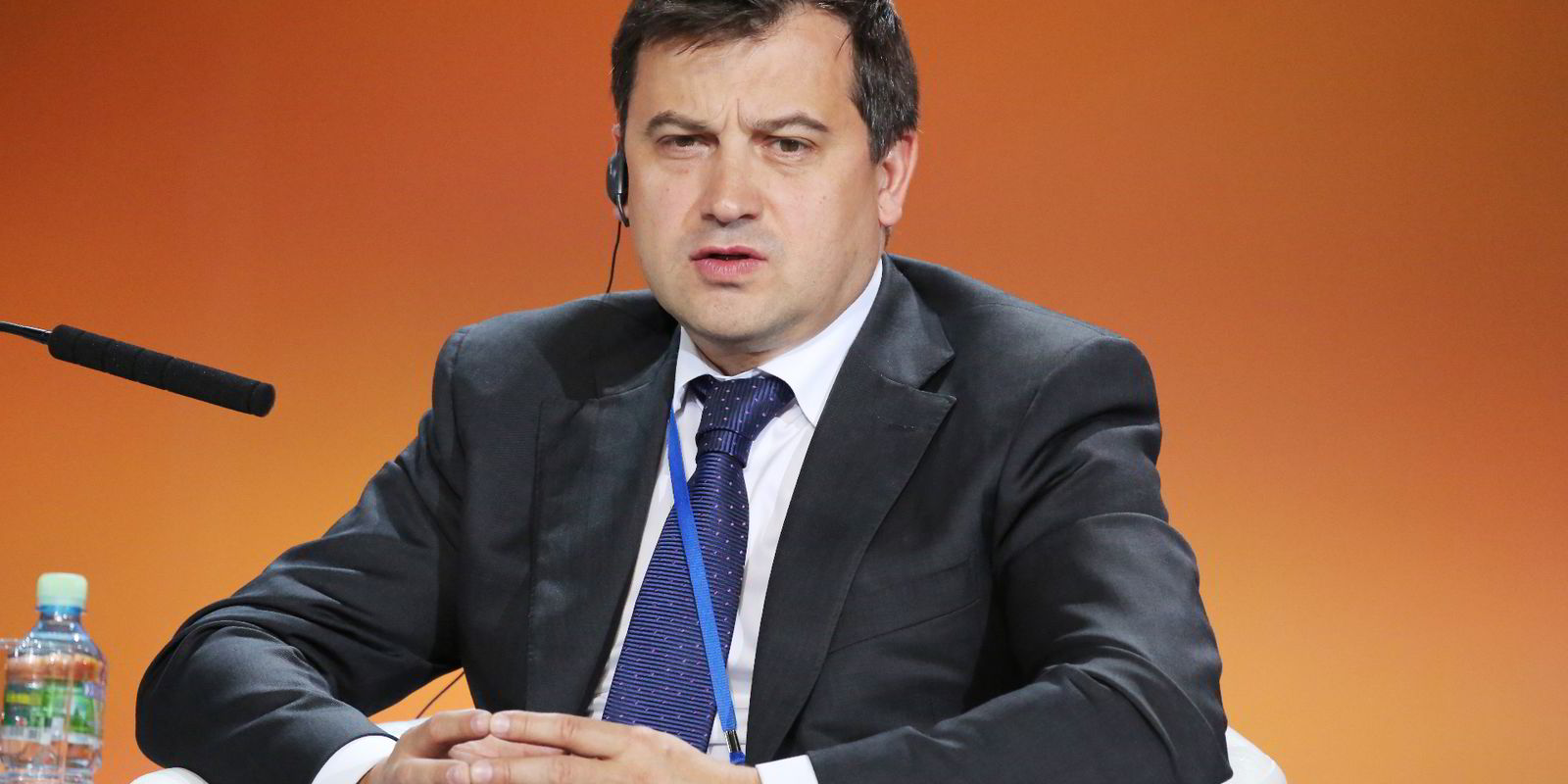
Crab, to-go
Phillips is busy rolling out several new products at the show this year, including it’s to-go line of products like crab cakes and crab cake minis.
“The concept is that it’s actually from our restaurants,” Phillips Vice President of Marketing Caroline Tippett told IntraFish. “It looks like it’s a to-go box.”
The company also rolled out a culinary crab product, which they have been working on for a couple of years, Tippett said. It’s jumbo lump crab meat shaped from smaller crab pieces, which holds together well -- “it’s not going to break apart -- and is cheaper than market price.
Other new items include an albacore tuna line for foodservice and new products to Phillips’ Seafood Skillets line.
--Avani Nadkarni
-------------------------------------------------
Sunday, March 10, 11:30 a.m. EST

FDA CO treatment ban could hurt Harbor
Harbor Seafood has rolled out a new line of mahi mahi which is CO treated, and the company’s Greg Davis told IntraFish the possible Food and Drug Administration ban on the treatment would be a hindrance to industry.
“There’s no health challenge, no allergen challenge,” Davis told IntraFish. “The issue is misuse, [people] trying to hide low-grade products.”
--Avani Nadkarni
-----------------------------------------

Sunday, March 10, 11.20 a.m. EST
Same crab, more meat
North Carolina-based Shure Foods has a new solution for getting more meat out of crabs.
The company’s Kevin Hartigan said it’s “never been done before,” and Shure Foods’ cold structured crab allows chefs to have already-cooked crab meat rings, sheets and stuffed crab to cook with.
“Traditional hand-picking gets 40 percent of the meat out of the crab, ours gets 90 percent,” Hartigan told IntraFish.
-- Avani Nadkarni
-------------------------------------------
Sunday, March 10, 11.18 a.m. EST
Shrimp: Retail going down

The company is therefore putting greater focus on foodservice in 2013, Richard Aro (pictured left), vice president at the company told IntraFish.
“Consumers are not spending as much money in supermarkets,” he said.
Geisha recently introduced pasteurised crab to its product line, and is hoping to expand it in restaurants all over the United States this year.
“Hopefully that’s going to boost sales,” Aro said. Value-added products (VAP) on the other hand have lost “a lot” of market share, he said.
-- Elisabeth Fischer
-------------------------------------------------
Sunday, March 10, 10.58 a.m. EST
Pescanova: ‘Business as usual'
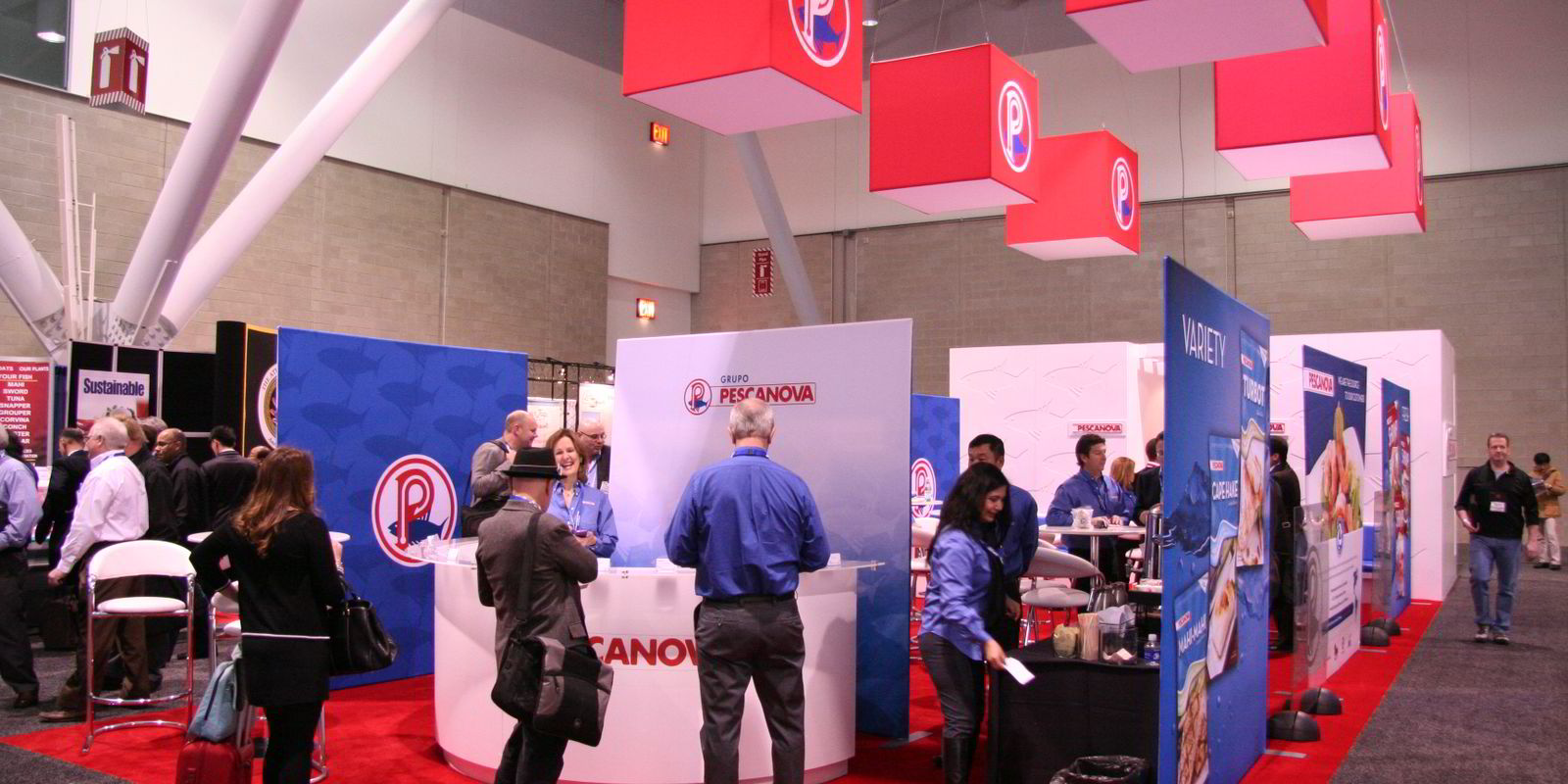
When asked about their thoughts on the company’s future, one person at the stand, who didn’t want to be named, said it’s just “business as usual.”
“We’re waiting for the banks to solve the situation,” IntraFish was told. “We have no other comments to make.”
-- Elisabeth Fischer
-------------------------------------------------
Saturday, March 9, 6:30 p.m. EST
First fish off the farm
Cooke Aquaculture will be in Boston with the first salmon produced at its new St. Marys Bay site.
The company on Thursday began harvesting the first batch of fish ever produced at the site.
Cooke planted about 700,000 fish in the pens at two sites in St. Marys in July 2011. Today, the fish weigh an average of 10 pounds, reports the Herald newspaper.
The 700,000 fish represent about seven million pounds of salmon to be harvested.
-- John Fiorillo
-------------------------------------------------
Saturday, March 9, 7:20 a.m. EST
Boston vs. Brussels
When it comes to the world’s most recognized and largest seafood trade shows, the International Boston Seafood Show and the European Seafood Exposition in Brussels top the list. But how do these shows compare to one another?
| Boston seafood Show | Brussels seafood show | |
| Number of exhibiting companies | 1,000 from over 40 countries | 1,600 from over 70 countries |
| Number of seafood professionals who attend | 19,000 | 26,000 |
| Year launched | 1987 | 1993 |
Looking for anybody special at Boston? Click here for the show's full exhibitor list.
-- John Fiorillo
---------------------------------------------
Saturday, March 9, 7:20 a.m. EST
The party's over
When it comes to company parties during the Boston seafood show, The Mazzetta Company has set the standard for the past 25 years. But the party's over.
The company has decided to discontinue its annual festivities this year, said Jeff Goldberg of Mazzetta. "After the 25th year we decided to no longer throw the party," he said.
-- John Fiorillo
-------------------------------------------------

Click here to go to High Liner Foods
-------------------------------------------------
Saturday, March 9, 7 a.m. EST
New seafood products attack Boston
Looking for new products at this year's show? There are plenty from which to choose.
Below is a list of finalists for this year's Seafood Excellence Awards, the -new products competition held in conjunction with the International Boston Seafood Show.
Finalists compete for two awards: Best New Foodservice Product and Best New Retail Product. This year’s 10 finalists were hand-selected from over 70 entries.
The finalists for the 2013 Seafood Excellence Awards are:
ACME Smoked Fish, Booth 718
Wild Smoked Salmon Crepes
Gulf Pride Enterprise, Booth 2143
Gulf Pride Select Shrimp and Grits
Handy International Incorporated, Booth 823
Shrimp & Grits Cakes
High Liner Foods, Booth 1005
South Paws Hush Puppy Coated Flounder 4-5 oz.
Phillips Foods, Inc., Booth 1016
Culinary Jumbo Lump &
Culinary Super Lump Crab Meat
King & Prince Seafood, Booth 505
Sushi Bob
Simple Salmon, Booth 2267
Salmon Chorizo Sausage
Soho Foods, LLC, Booth 2165
Superfrozen Tuna, Philfresca Brand
(Saku, Loins, Steaks and Sushi Slice)
St. Mary's River Smokehouses, Booth 1440
Oven Smoked Salmon Stix
The Saucy Fish Co., Booth 2554
Salmon Fillets with Chili Lime & Ginger Dressing
The winners will be announced at Seafood Excellence Awards ceremony in the Demonstration Theater in the Exhibit Hall, Booth 2567 on Sunday, March 10 at 3:30 p.m.
-- John Fiorillo
